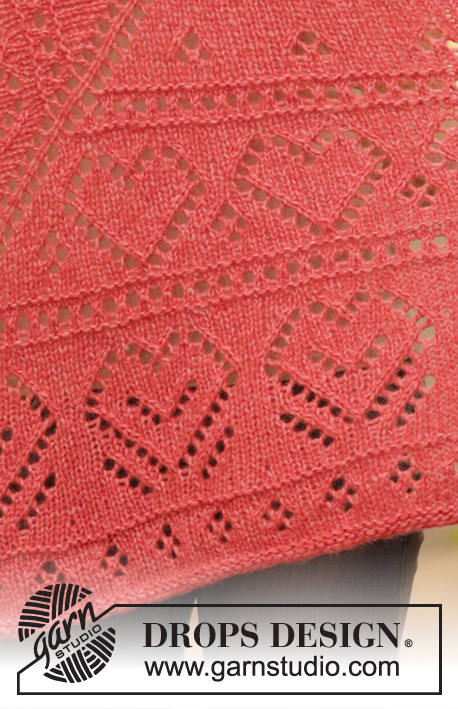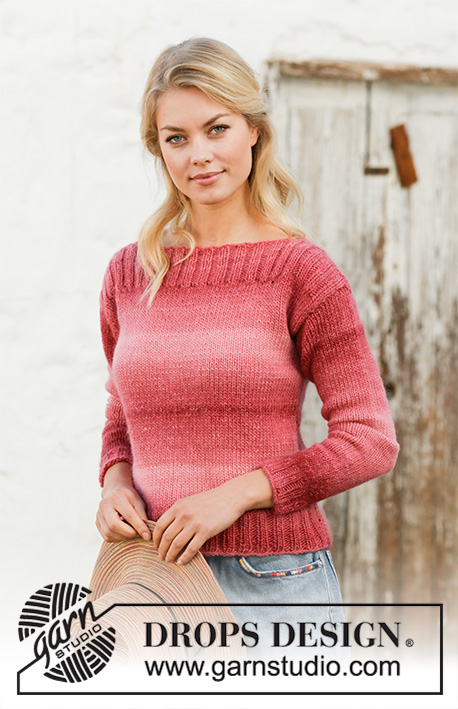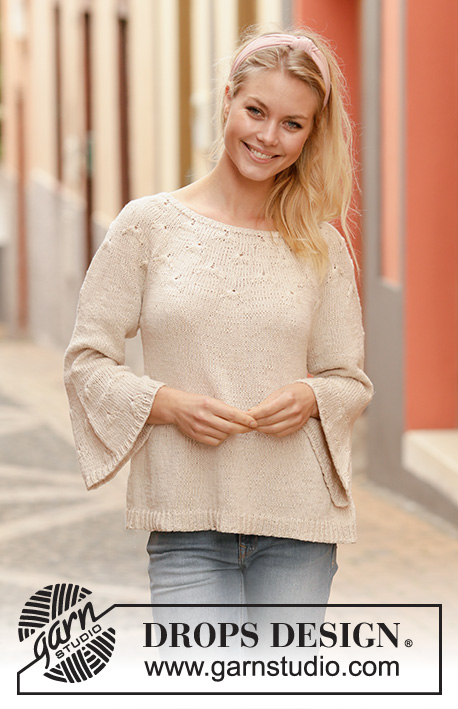Comments / Questions (32)
![]() Sherry Fisher wrote:
Sherry Fisher wrote:
Were is the corrected graph 1 4
15.01.2025 - 04:03DROPS Design answered:
Dear Mrs Fisher, if you printed the pattern after the date of the correction, then diagram is right as it is now online. The corrections only apply if you printed the patterns before these dates. Happy knitting!
15.01.2025 - 09:10
![]() Alice wrote:
Alice wrote:
Buongiorno, no riesco a capire come fare questo modello perché dalla foto sembra che il primo motivo sia quello con 4 punti traforati e non tre come nei diagrammi A1/A2, ma come quelli A18 ecc ecc, e lo stesso per i cuori che sembrano invertiti di verso e ordine… cosa sto sbagliando? Grazie in anticipo!
28.12.2024 - 10:24DROPS Design answered:
Buonasera Alice, le istruzioni sono corrette. I diagrammi si leggono dal basso verso l'alto da destra verso sinistra. Buon lavoro!
30.12.2024 - 00:18
![]() Sherry Fisher wrote:
Sherry Fisher wrote:
Instructions. Unclear for diagraham 12 - 15 Have 127 stitches 2 + 61+1 + 61 + 2 =127 Work 2 edge stitches in garter stitch, A.12 over 15 stitches, work A.13 until 14 stitches remain before middle stitch (2 times in width), A.14 over 14 stitches, 1 middle stitch in stockinette stitch, A.12 over 15 stitches, repeat A.13 until 16 stitches remain on row (2 times in width),
05.12.2024 - 06:38DROPS Design answered:
Hi Sherry, 2 + 15 + 32 (2 x A.13) + 14 + 1 +15 + 32 (2 x A.13) = 111 stitches, with 16 stitches left. A total of 127 stitches. Happy knitting!
05.12.2024 - 12:54
![]() Sherry wrote:
Sherry wrote:
Help graph 9 - 11 Knit 2 garter then Y/O then - knit 2 YO1 till middle then 2
19.11.2024 - 15:06DROPS Design answered:
Dear Sherry, on the first row in A.9-A.11 work: 2 sts in garter stitch, A.9 (= YO, K3), repeat A.10 (k2) until 2 sts remain before middle stitch, then work A.11 (K2, YO), work the middle stitch, then work A.9 (= YO, K3), repeat A.10 (k2) until 4 sts remain before the end of the row, then work A.11 (K2, YO), and finish with 2 sts in garter stitch. Happy knitting!
19.11.2024 - 16:19
![]() Natalia wrote:
Natalia wrote:
Dzień dobry, Czy da się powiększyć tę chustę? Jeśli tak to w jaki sposób?
23.10.2024 - 10:23DROPS Design answered:
Witaj Natalio, możesz powiększyć szal wybierając dowolny wzór np. z tych podanych wcześniej. Pamiętaj tylko że musisz dodawać 4 oczka co 2 rzędy na poszerzanie szala (jak dotychczas) - czyli dodajesz po 1 o. na bokach i 2 oczka na środku szala. Pozdrawiamy!
23.10.2024 - 13:41
![]() Sarah BOUTON wrote:
Sarah BOUTON wrote:
Bonjour je ne comprends pas pourquoi le tricot commence par le montage de seulement 7mailles alors qu'il se tricote de haut en bas. Est ce qu'il se tricote en une fois ou deux parties assemblées ensuite? Merci
02.06.2024 - 22:11DROPS Design answered:
Bonjour Mme Bouton, le châle se tricote de haut en bas, en commençant par juste 7 mailles; on va ensuite augmenter 4 mailles tous les 2 rangs (tous les rangs sur l'endroit) pour former le triangle, le dernier rang correspond aux 2 diagonales du châle et la largeur en haut du châle (d'une pointe à l'autre) aux débuts/fins de rangs de chaque côté de la maille centrale. Bon tricot!
03.06.2024 - 08:15
![]() Élise Deschatelets wrote:
Élise Deschatelets wrote:
Bonjour, Est-ce que les augmentations ( jetés) sont tricotées sur le rang envers en mailles torses? Avant les diagrammes À.12- À.14 Merci
10.02.2023 - 18:49
![]() Élise Deschatelets wrote:
Élise Deschatelets wrote:
Bonjour, Est-ce que les augmentations ( jetés) sont tricotées sur le rang envers en mailles torses? Avant les diagrammes À.12- À.14 Merci
10.02.2023 - 18:46DROPS Design answered:
Bonjour Mme Deschatelets, les augmentations se tricotent comme indiqué dans les diagrammes, autrement dit, jusqu'aux diagrammes A.18, on va les tricoter à l'envers sur l'envers, et dans A.18-19-20, on les tricote à l'endroit sur l'endroit, comme les autres mailles au 2ème, 14èm e et 16ème rang. Bon tricot!
13.02.2023 - 08:52
![]() Carla wrote:
Carla wrote:
Sono arrivata al 3ferro dei A12 A13 A14, alla fine della seconda sequenza del A13 ho 14maglie come da spiegazione ma il A14 è formato da 15 maglie. Come procedo.? Grazie
16.01.2023 - 13:47DROPS Design answered:
Buonasera Carla, il terzo ferro di A.14 ha 15 maglie perchè è stata aumentata 1 maglia con 1 gettato nel 1° ferro. La spiegazione nel testo è riferita al 1° ferro. Buon lavoro!
16.01.2023 - 22:33
![]() Catherine wrote:
Catherine wrote:
Bonjour Magnifique modèle, mais je ne vois pas les diagrammes de 1 à 5. Merci pour votre réponse.
11.12.2022 - 11:18DROPS Design answered:
Bonjour Catherine, vous trouverez les diagrammes juste sous la légende, et en hauteur, dans l'ordre: A.1 et A.2, puis A.3, A.4 et A.5, puis A.9, A.10 et A.11 etc. Bon tricot!
12.12.2022 - 09:30
Heart Me#heartmeshawl |
|||||||||||||||||||
 |
 |
||||||||||||||||||
Knitted shawl in DROPS Air. Piece is knitted top down with lace pattern and garter stitch.
DROPS 202-24 |
|||||||||||||||||||
|
---------------------------------------------------------- EXPLANATION FOR THE PATTERN: ---------------------------------------------------------- GARTER STITCH (back and forth): K all rows. 1 ridge vertically = knit 2 rows. PATTERN: See diagrams A.1 and A.20. Diagrams show all rows in pattern seen from the right side. ---------------------------------------------------------- START THE PIECE HERE: ---------------------------------------------------------- SHAWL - SHORT OVERVIEW OF THE PIECE: Worked back and forth on circular needle to make room for all the stitches. SHAWL: Cast on 7 stitches on circular needle size 5.5 mm with Air. Knit 1 row from wrong side. Knit 2, 1 yarn over, knit 1, 1 yarn over, knit 1, 1 yarn over, knit 1, 1 yarn over and knit 2 = 4 stitches increased, 11 stitches on row. Knit 1 row from wrong side. Insert 1 marker in the middle stitch, this is mid stitch and should be worked in stocking stitch the entire time (= knit from right side and purl from wrong side). Work according to diagram A.1-A.2 as follows from right side: Work 2 edge stitches in GARTER STITCH - see explanation above, work A.1 over 3 stitches, 1 middle stitch in stocking stitch, A.2 over 3 stitches and 2 edge stitches in garter stitch. When diagrams A.1 and A.2 have been worked 1 time vertically, there are 39 stitches on row. Work according to diagram A.3-A.8 as follows from right side: Work 2 edge stitches in garter stitch, A.3 over 1 stitch, A.4 over 10 stitches (1 time in width), A.5 over 6 stitches, 1 middle stitch in stocking stitch, A.6 over 6 stitches, A.7 over 10 stitches (1 time in width) and A.8 over 1 stitch and 2 edge stitch in garter stitch. When diagrams have been worked 1 time vertically, there are 99 stitches on row. Work according to diagram A.9-A.11 as follows from right side: Work 2 edge stitches in garter stitch, A.9 over 3 stitches, work A.10 until 2 stitches remain before middle stitch, work A.11 over 2 stitches, work 1 middle stitch in stocking stitch, work A.9 over 3 stitches, work A.10 until 4 stitches remain on row, work A.11 over 2 stitches and 2 edge stitches in garter stitch. When diagrams have been worked 1 time vertically, there are 115 stitches on row. Work next row as follows from right side: Work 2 edge stitches in garter stitch, 1 yarn over, knit and increase 4 stitches evenly over the next 55 stitches (= until middle stitch), 1 yarn over, 1 middle stitch in stocking stitch, 1 yarn over, knit and increase 4 stitches evenly over the next 55 stitches, 1 yarn over and 2 edge stitches in garter stitch (= 12 stitches increased in total). There are 127 stitches on needle. Purl 1 row from wrong side (work middle stitch in stocking stitch and work edge stitches in garter stitch). Work according to diagram A.12-A.14 as follows from right side: Work 2 edge stitches in garter stitch, A.12 over 15 stitches, work A.13 until 14 stitches remain before middle stitch (2 times in width), A.14 over 14 stitches, 1 middle stitch in stocking stitch, A.12 over 15 stitches, repeat A.13 until 16 stitches remain on row (2 times in width), work A.14 over 14 stitches and work 2 edge stitches in garter stitch. When diagrams have been worked 1 time vertically, there are 167 stitches on row. Work according to diagram A.9-A.11 as follows from right side: Work 2 edge stitches in garter stitch, A.9 over 3 stitches, work A.10 until 2 stitches remain before middle stitch, work A.11 over 2 stitches, work 1 middle stitch in stocking stitch, work A.9 over 3 stitches, work A.10 until 4 stitches remain on row, work A.11 over 2 stitches and 2 edge stitches in garter stitch. When diagrams have been worked 1 time vertically, there are 183 stitches on row. Work next row as follows from right side: Work 2 edge stitches in garter stitch, 1 yarn over, knit and increase 10 stitches evenly over the next 89 stitches (= until middle stitch), 1 yarn over, 1 middle stitch in stocking stitch, 1 yarn over, knit and increase 10 stitches evenly over the next 89 stitches, 1 yarn over and 2 edge stitches in garter stitch (= 24 stitches increased in total). There are 207 stitches on needle. Purl 1 row from wrong side (work middle stitch in stocking stitch and work edge stitches in garter stitch). Work according to diagram A.15-A.17 as follows from right side: Work 2 edge stitches in garter stitch, A.15 over 14 stitches, repeat A.16 until 15 stitches remain before middle stitch (4 times in width), A.17 over 15 stitches, 1 middle stitch in stocking stitch, A.15 over 14 stitches, repeat A.16 until 17 stitches remain on row (4 times in width), work A.17 over 15 stitches and 2 edge stitches in garter stitch. When diagrams have been worked 1 time vertically, there are 259 stitches on row. Work next row as follows from right side: Work 2 edge stitches in garter stitch, 1 yarn over, knit and increase 6 stitches evenly over the next 127 stitches (= until middle stitch), 1 yarn over, 1 middle stitch in stocking stitch, 1 yarn over, knit and increase 6 stitches evenly over the next 127 stitches, 1 yarn over and 2 edge stitches in garter stitch (= 16 stitches increased in total). There are 275 stitches on needle. Purl 1 row from wrong side (work middle stitch in stocking stitch and work edge stitches in garter stitch). Work according to diagram A.18-A.20 as follows from right side: Work 2 edge stitches in garter stitch, A.18 over 5 stitches, repeat A.19 until 4 stitches remain before middle stitch (21 times in width), A.20 over 4 stitches, 1 middle stitch in stocking stitch, A.18 over 5 stitches, repeat A.19 until 6 stitches remain on row (21 times in width), work A.20 over 4 stitches and 2 edge stitches in garter stitch. When diagrams have been worked 1 time vertically, there are 307 stitches on row. Cast off by knitting on next row from right side, make sure to avoid a tight edge, use a larger needle size if needed for cast-off. |
|||||||||||||||||||
Diagram explanations |
|||||||||||||||||||
|
|||||||||||||||||||

|
|||||||||||||||||||

|
|||||||||||||||||||

|
|||||||||||||||||||

|
|||||||||||||||||||

|
|||||||||||||||||||
Have you finished this pattern?Tag your pictures with #dropspattern #heartmeshawl or submit them to the #dropsfan gallery. Do you need help with this pattern?You'll find 17 tutorial videos, a Comments/Questions area and more by visiting the pattern on garnstudio.com. © 1982-2025 DROPS Design A/S. We reserve all rights. This document, including all its sub-sections, has copyrights. Read more about what you can do with our patterns at the bottom of each pattern on our site. |
|||||||||||||||||||



























































Post a comment to pattern DROPS 202-24
We would love to hear what you have to say about this pattern!
If you want to leave a question, please make sure you select the correct category in the form below, to speed up the answering process. Required fields are marked *.